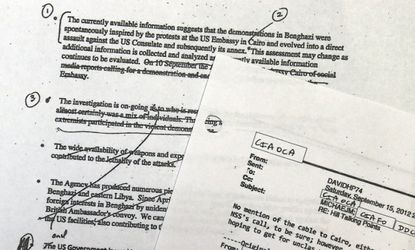5 things we learned from the White House's Benghazi email dump
So, was there any "there" there?


On Wednesday evening, at what Slate's David Weigel snidely calls "the convenient 5 p.m. hour," the White House released 100 emails detailing the bureaucratic sausage-making that created the Obama administration's first unclassified talking points on the Sept. 11, 2012, attack on the U.S. diplomatic compound in Benghazi, Libya.
The 99 emails and one handwritten page of edits add a lot of detail to what we generally already knew about the talking points — which means that if you had strong opinions about the Benghazi debacle and its aftermath already, you can probably find something in the 100 pages to support your beliefs.
"As has been widely reported, it was the State Department that drove the dumbing down of the talking points," says John Hinderaker at PowerLine. And "the emails make another key point crystal clear: The administration molded the talking points for the specific purpose of counteracting the news, which was already starting to get traction, that what happened in Benghazi was a planned terrorist attack." And that's no surprise, Hinderaker adds, because strikingly, "the process was driven entirely by political operatives."
Subscribe to The Week
Escape your echo chamber. Get the facts behind the news, plus analysis from multiple perspectives.

Sign up for The Week's Free Newsletters
From our morning news briefing to a weekly Good News Newsletter, get the best of The Week delivered directly to your inbox.
From our morning news briefing to a weekly Good News Newsletter, get the best of The Week delivered directly to your inbox.
Looking at the same emails, Hayes Brown at Think Progress says these new documents "seem to undermine GOP claims that the White House orchestrated a 'cover-up,'" and "debunk the basis many of the Republican's claims of a conspiracy." It was the CIA, not the State Department or White House staff, that introduced the idea of pre-attack demonstrations and nixed all mention of al Qaeda — and not for political reasons. The CIA was under "express instructions" to avoid any information that would compromise the FBI's investigation.
The emails did clear up some points in this long-simmering flap, however. Here, five things we learned from the Benghazi email dump:
1. The CIA drove the talking points process
The emails — dating from Friday, Sept. 14, just before noon to Saturday, Sept. 15, just before 8 p.m. — indicate that there was input from the CIA, FBI, State Department, White House, and other intelligence agencies, but it's clear that the talking points began and ended with the CIA. Agency staffers wrote the first drafts of the talking points, in response to a request from Rep. C.A. Dutch Ruppersberger (D-Md.), the top Democrat on the House Intelligence Committee. And the person responsible for whittling the original five points down to three was CIA Deputy Director Michael Morell.
Sign up for Today's Best Articles in your inbox
A free daily email with the biggest news stories of the day – and the best features from TheWeek.com
It was Morell, much to his boss' apparent annoyance, who took out all references to "Islamic" extremists, the large amounts of guns floating around in Libya, and the CIA warnings about "the threat of extremists linked to al Qaeda in Benghazi and Eastern Libya."
Morell "felt the talking points should focus on what happened in Benghazi on September 11, rather than the previous six months," says CNN's Jake Tapper, citing senior Obama administration officials. "He also felt it was unprofessional and unfair for the CIA to cite its own warnings to the State Department."
2. The incorrect pre-attack protest detail was the CIA, too
A major GOP point of criticism of the Obama team's response to the attack was the erroneous claim that the siege was preceded by a spontaneous protest, inspired by a similar protest outside the U.S. embassy in Cairo. That claim — which senior U.S. officials say reflects the best intelligence at the time — was part of the original CIA talking points, and CIA officials steered the talking points more explicitly toward highlighting a demonstration.
U.N. Ambassador Susan Rice has faced the brunt of the criticism on this point. Rice's appearance on Sunday talk shows on Sept. 16 — in which she relied on the talking points to argue that the attacks probably grew out of a protest of an anti-Islam video — likely cost her a promotion to secretary of State. And it's technically true, as PowerLine's Hinderaker notes, that "there is no reference to any YouTube video" in any version of the talking points. But the protest in Cairo, which all versions of the talking points say inspired the mythical Benghazi protest, were explicitly in reaction to the YouTube video.
The last email in the pack is from White House Deputy National Security Adviser Ben Rhodes to one of Rice's aides. "Is this the final language you want to use on Benghazi?" the unidentified aide asks. "Have short window to get her something on paper soon." Rhode's one-word response: "Yup."
3. Most of the objections did come from the State Department
The White House "quickly" cleared the talking points, and the FBI cleared them "with a few comments," a CIA staffer wrote to CIA Director David Petraeus at 9:52 p.m. on Friday. But the State Department "has major concerns."
That the State Department — which wasn't roped into the discussion until the fourth draft — would raise the most objections to the CIA's talking points isn't surprising, say Scott Wilson and Karen DeYoung at The Washington Post. "The two agencies had the most at stake in the Benghazi aftermath," and their main dispute was "whether previous CIA warnings of attacks in the Benghazi area should be included in those initial public statements." Fairly or not, mention of prior warnings would have made the CIA look good and the State Department bad.
Senior intelligence officials who briefed the media on the emails say that Morell scratched the section about the CIA warnings even before hearing about the State Department's objections — the emails don't prove this either way, since Morell's edits (in which he did cross out the CIA warnings) are handwritten and have no timestamp.
4. The White House changed more than one word
After Morell made the final changes to the talking points, whittling them down from five to three and stripping out much of the interesting stuff, Rhodes offered "one edit, for accuracy": Change "consulate" to "diplomatic post." That fits with White House press secretary Jay Carney's contention the the White House changed only one word, "consulate." But on Friday evening, Tommy Vietor — then NSA spokesman — also asked that the CIA add the word "Cairo" to the talking point about the previous protests in Egypt.
State Department official Jacob Sullivan echoed Rhodes on Saturday afternoon, asking that the CIA change "consulate" to "the U.S. mission" or "U.S. diplomatic post" for the final version. But Sullivan also noted that "there is a missing 'of' in the third" talking point.
John Brennan, now the CIA director but then a deputy national security adviser, revised a talking point about the makeup of the crowd that gathered around the Benghazi mission, though he left in that "Islamic extremists participated in the demonstrations." Morell later scratched that entire talking point.
5. David Petraeus didn't care for the final talking points
In the mess of emails, there are a few informing Petraeus about the status of the talking points, but only one from Petraeus himself. At 12:51 p.m. on Saturday, a CIA staffer emailed the final draft to Petraeus for his approval. He didn't much approve. Here is his response, at 2:27, in full:
No mention of the cable to Cairo, either? Frankly, I'd just as soon not use this, then... [National Security Council staff's] call, to be sure; this is certainly not what Vice Chairman Ruppersberger was hoping to get for [unclassified] use.
We also learned one trivial thing about Petraeus:
Sources: The Associated Press, CNN (2), McClatchy, The New York Times, PowerLine, Slate, Think Progress, The Wall Street Journal
Create an account with the same email registered to your subscription to unlock access.
Peter has worked as a news and culture writer and editor at The Week since the site's launch in 2008. He covers politics, world affairs, religion and cultural currents. His journalism career began as a copy editor at a financial newswire and has included editorial positions at The New York Times Magazine, Facts on File, and Oregon State University.
-
 'Criminal trail?'
'Criminal trail?'Today's Newspapers A roundup of the headlines from the US front pages
By The Week Staff Published
-
 Grindr 'shared user HIV status' with ad firms, lawsuit claims
Grindr 'shared user HIV status' with ad firms, lawsuit claimsSpeed Read LGBTQ dating app accused of breaching UK data protection laws in case filed at London's High Court
By Rebecca Messina, The Week UK Published
-
 The best dog-friendly hotels around the UK
The best dog-friendly hotels around the UKThe Week Recommends Take a break with your four-legged friend in accommodation that offers you both a warm welcome
By Adrienne Wyper, The Week UK Published
-
 Arizona court reinstates 1864 abortion ban
Arizona court reinstates 1864 abortion banSpeed Read The law makes all abortions illegal in the state except to save the mother's life
By Rafi Schwartz, The Week US Published
-
 Trump, billions richer, is selling Bibles
Trump, billions richer, is selling BiblesSpeed Read The former president is hawking a $60 "God Bless the USA Bible"
By Peter Weber, The Week US Published
-
 The debate about Biden's age and mental fitness
The debate about Biden's age and mental fitnessIn Depth Some critics argue Biden is too old to run again. Does the argument have merit?
By Grayson Quay Published
-
 How would a second Trump presidency affect Britain?
How would a second Trump presidency affect Britain?Today's Big Question Re-election of Republican frontrunner could threaten UK security, warns former head of secret service
By Harriet Marsden, The Week UK Published
-
 'Rwanda plan is less a deterrent and more a bluff'
'Rwanda plan is less a deterrent and more a bluff'Instant Opinion Opinion, comment and editorials of the day
By The Week UK Published
-
 Henry Kissinger dies aged 100: a complicated legacy?
Henry Kissinger dies aged 100: a complicated legacy?Talking Point Top US diplomat and Nobel Peace Prize winner remembered as both foreign policy genius and war criminal
By Harriet Marsden, The Week UK Last updated
-
 Trump’s rhetoric: a shift to 'straight-up Nazi talk'
Trump’s rhetoric: a shift to 'straight-up Nazi talk'Why everyone's talking about Would-be president's sinister language is backed by an incendiary policy agenda, say commentators
By The Week UK Published
-
 More covfefe: is the world ready for a second Donald Trump presidency?
More covfefe: is the world ready for a second Donald Trump presidency?Today's Big Question Republican's re-election would be a 'nightmare' scenario for Europe, Ukraine and the West
By Sorcha Bradley, The Week UK Published